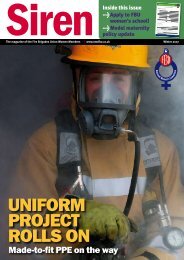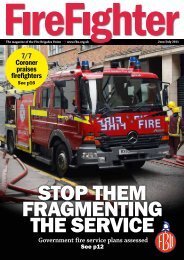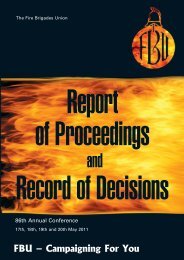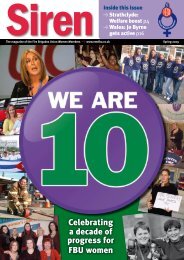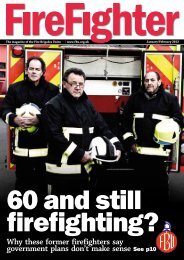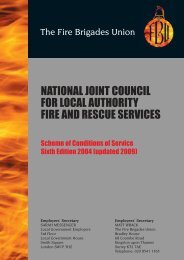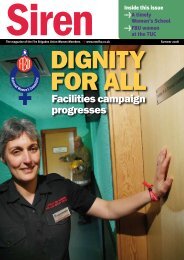Report - Fire Brigades Union
Report - Fire Brigades Union
Report - Fire Brigades Union
You also want an ePaper? Increase the reach of your titles
YUMPU automatically turns print PDFs into web optimized ePapers that Google loves.
SECTION B — FIRE AND RESCUE SERVICE POLICY<br />
Procurement<br />
Centralised procurement is one of the functions that<br />
arguably should remain at the national level to help make<br />
local resources go further. However, the agency “<strong>Fire</strong>buy”<br />
has recently been abolished as part of the Government’s<br />
policy of reducing NDPBs and hence a new approach will<br />
be necessary for this function.<br />
Theoretically, centralised procurement should be able to<br />
acquire goods at a lower cost than individual FRAs.<br />
However, with <strong>Fire</strong>buy this was not always perceived to be<br />
the case. FRAs may have contributed to this by demanding<br />
too wide a variety of specifications for products they were<br />
requesting, which reduced the scope for economies of<br />
scale in bulk purchasing. Government has made it clear<br />
that procurement is a matter for the sector to take forward<br />
and FRAs will need to act together effectively to agree<br />
common specifications and new joint procurement<br />
mechanisms. A catalyst for this could well be collective<br />
development of operational procedures which would<br />
encourage harmonisation. Areas listed earlier highlight<br />
some of the opportunities both for savings through<br />
collective purchasing and, in many cases, areas where<br />
standardisation will enhance inter-operability.<br />
Research and development capacity is not collectively<br />
harnessed in the sector and there is a strong case that this<br />
would be better delivered on a collective basis which<br />
would in turn promote a more coherent dialogue with<br />
suppliers.<br />
7. FUNDING STRUCTURES<br />
The FRS is a front line emergency service, which serves all<br />
parts of the public, private, and personal sectors. This<br />
suggests perhaps that the current funding structure based<br />
on government grants funded by national taxation,<br />
business rates, and council tax, with a small amount of<br />
recharges and income generation is broadly right as a<br />
concept. The issue therefore is whether changes in the<br />
relative balance between the individual elements would<br />
more accurately reflect the incidence of costs and benefits.<br />
8. AGGREGATE FINANCIAL PROVISION<br />
The present aggregate national provision for FRS spending<br />
has been arrived at incrementally, and not though a bottom<br />
up assessment of the cost of resourcing local patterns of<br />
risk. For many years, the Service has argued that total<br />
provision has not kept pace with the expansion in the role<br />
of Service, or the addition of new expectations in areas<br />
such as RTCs, water rescue, and cliff rescue. This has<br />
been compounded by authorities receiving unequal<br />
settlements, based on a limited and outdated funding<br />
formula, which fails to reflect key resource drivers for<br />
some FRAs such as geographical sparsity. The recent<br />
debate about flood response is a good example of where<br />
there is lack of clarity about the Service’s statutory<br />
requirements and their resourcing. The picture is<br />
complicated by national initiatives such as New<br />
Dimensions, which are well intentioned in terms of<br />
recognising new needs, but even the funding for that<br />
initiative lacks permanence in a number of important areas.<br />
In reviewing aggregate funding provision, a reliable base<br />
position is essential. A national risk assessment, looking at<br />
risks facing the nation, but not providing a national standard<br />
for emergency cover, might provide the basis for this, from<br />
which authorities could then build local services through<br />
local choice. Differential precepting could make local choice<br />
even more tailored and would also facilitate combination of<br />
authorities where previously council tax differentials have<br />
provided an insurmountable obstacle. At present, the<br />
Service lacks a robust mechanism for modelling the<br />
financial requirements of each FRA’s risk-based resourcing.<br />
The more localised approach which came with the<br />
introduction of IRMP has in some ways made it more<br />
difficult to generate a nationally applicable model.<br />
Protection of capital funding streams is a central theme of<br />
the Service’s development plans:<br />
●<br />
●<br />
●<br />
●<br />
Investment in new stations is often the catalyst to<br />
achieve efficiency savings, either in running costs or<br />
from two-into-one initiatives, this could be looked at<br />
cross service and from a locality perspective, rather<br />
than just within the FRS;<br />
Similarly, new types of vehicles, in particular combined<br />
aerial/pumping appliances, can enable the Service to<br />
operate with a smaller workforce;<br />
Delayed replacement of buildings and equipment may<br />
save investment in the short term, but can be very<br />
quickly offset by increases in repair and maintenance,<br />
or lower reliability;<br />
Jointly used community safety facilities, or combined<br />
emergency service sites, are likely to require new<br />
investment.<br />
If capital grant availability is restricted, there would be merit<br />
in a national Invest to Save Fund dedicated for the FRS,<br />
under which initial funding could be made available from<br />
the centre on the basis that part of the future revenue<br />
savings would be redirected back to the Treasury. This<br />
could also be linked to delivering change in specific areas<br />
and may well be better targeted at schemes which deliver<br />
wider involvement and therefore have the potential to<br />
deliver wider benefits and bigger savings.<br />
Specific grant funding is under pressure within the<br />
Comprehensive Spending Review 2010. In a situation<br />
where all sources of funding will be restricted, there are<br />
advantages to the service in securing as much as possible<br />
through non-hypothecated funding streams, which allows<br />
maximum local flexibility.<br />
The introduction of area based funding would of course<br />
have a major impact in changing the nature of local<br />
services and might drive service provision away from a risk<br />
resourcing basis. However, it would also provide a<br />
significant driver for change at a local level towards more<br />
integrated service provision and it is recommended that<br />
the implications of such an alternative funding approach are<br />
fully explored for fully or part funding local <strong>Fire</strong> and Rescue<br />
Services in the longer term.<br />
46 FBU Annual <strong>Report</strong> 2011





